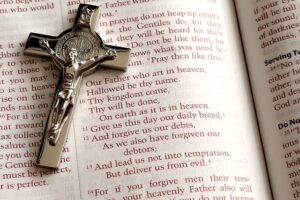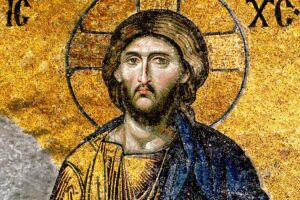Last edited on 22/Jan/2021
Christian Answer
Different Interpretations of the Passage
This is he who came by water and blood—Jesus Christ; not by the water only but by the water and the blood. And the Spirit is the one who testifies, because the Spirit is the truth. 7 For there are three that testify: 8 the Spirit and the water and the blood; and these three agree. (1 John 5:6–8, ESV)
The phrase used in 1 John 5:6 “This is he who came by water and blood” is considered by many to be one of the most perplexing passages in the whole New Testament. Not surprisingly, many have offered different interpretations of it as a result. Martin Luther and John Calvin believed that the water refers to baptism while the blood refers to the Lord’s Supper; they saw it as a perpetual process by which Jesus came to us in the sacraments.1 Clement of Alexandria believed that the water refers to regeneration and faith, while the blood refers to the public acknowledgement of that.2
Some say that by coming by water and blood, it is proving that Jesus came as a real man, made up of real human properties, who was born in a womb, and died a real death; this would be a refutation of Docetism*.2 Others say that it proves that Jesus is the Christ who accomplished both his baptism and crucifixion as one person, in refutation to Gnosticism.3 Hugo Grotius believed that the water refers to Jesus’ pure life, while the blood refers to his literal blood shed on the cross.2
Augustine believed that the water and blood refers to the water and blood that came from Jesus’ side after he was pierced upon his death on the cross, because the apostle paid careful attention to this in his Gospel account (John 19:34).1 The earliest known view was held by Tertullian, and he believed that the water refers to the waters of Jesus’ baptism, and the blood refers to the blood of his crucifixion.1
Out of all these interpretations, it would seem that the most correct one is Tertullian’s view: that the water refers to Jesus’ baptism, and the blood refers to his death on the cross, and that this, by extension, refutes Gnosticism. In addition, there also seems to be some truths behind the refutation of Docetism, as well as Augustine’s view, that they refer to the water and blood that came from his side, but these don’t seem to be the main focus.
What Do the Spirit, Water, and Blood “Testify”?
Let us examine why Tertullian’s view seems to be the most correct one. This passage is talking about the different things that testify to Jesus being the Son of God and that everyone who believes in him has eternal life. In the previous two verses, it says: “this is the victory that has overcome the world—our faith. 5 Who is it that overcomes the world except the one who believes that Jesus is the Son of God?” (1 John 5:4–5). In the verses after the passage, it says “And this is the testimony, that God gave us eternal life, and this life is in his Son. 12 Whoever has the Son has life; whoever does not have the Son of God does not have life” (1 John 5:11–12). Therefore, the water, the blood, and the Spirit (evidently, the Holy Spirit), are all testifying to this one fact: that Jesus is the Son of God, and that whoever believes in him has eternal life.
How Jesus’ Baptism, Crucifixion, and the Holy Spirit Relate to This Testimony
So then, how does Jesus’ baptism relate to this? It is very closely connected, because in Jesus’ baptism God the Father declared him to be his Son, and the Holy Spirit descended on him in the form of a dove as a witness to this (Matthew 3:16–17). This was also when he was anointed by the Holy Spirit into his ministry of teaching and healing (Luke 4:16–21). It relates to eternal life, because Jesus was baptised to begin his ministry by which he would fulfil the righteous requirement of the law on our behalf (Matthew 3:15; Matthew 5:17; Romans 8:3–4).
In the same way, Jesus’ death on the cross also testified to him being the Son of God. Some extraordinary historical events happened when Jesus was crucified: at the sixth hour, there was a supernatural darkness over all the land, which lasted for three hours; after he died, the temple curtain was torn in half; there was a rock-shattering earthquake; tombs were opened, and the Old Testament saints were resurrected, and were seen by many in Jerusalem (Matthew 27:45–53). After the centurion who was guarding Jesus while he hung on the cross saw the way in which he died, he was struck with awe, and confessed that he was truly the Son of God (Mark 15:39).4 It relates to eternal life, because Jesus died for our sins as our substitute in order to reconcile us to God the Father (Romans 4:23–25; Romans 5:10).
Likewise, the Holy Spirit testified to the fact that Jesus is the Son of God. This is clearly seen throughout the book of Acts, when he empowered the New Testament Christians to preach the gospel to the non-believers, worked miracles through them, and converted a phenomenal number of souls after the day of Pentecost (Acts 2:1–13). An example of such a moment was when the Holy Spirit entered Paul, formally a persecutor of the church, and then a few days later he went into synagogues proclaiming that Jesus “is the Son of God” (Acts 9:17, 20). The Holy Spirit also bears witness that Jesus’ death and resurrection has merited eternal life for Christians (Acts 5:27–32).
The Holy Spirit continues to work miracles today by converting people to the truth through the Gospel message, sometimes alongside visible signs (talking in real foreign languages, healing, etc.) (1 Corinthians 12:3), and this is his primary duty (Romans 1:1–4; John 15:26). There are a few more details that support the “water” of this passage referring to Jesus’ baptism. This interpretation is in agreement with John’s language. Because John said that he “came by” water and blood, which is a historical statement, instead of “comes by”, implying a perpetual process, this tells us that John was talking about specific events that happened in the past. John has also used “water” in reference to baptism before. In his Gospel, when Jesus spoke of the necessity of being born of water and the Spirit in John 3:5, he was referring to baptism.
Final Exegesis
Now let’s examine the whole passage, keeping this in mind. Jesus came by water and blood. This marks two very important moments in history. The first is that he was baptised, and this inaugurated him into office and revealed him as the Messiah, by the Holy Spirit and the Father’s witness.5,6 The second is his sacrificial death on the cross, where his Messianic work reached its culmination,⁵ and he paid the sin punishment on our behalf.
When John said that he did not come by the water only but by the water and the blood, he was just emphasising the importance of him accomplishing both parts of his ministry. He was countering the claim that Christ and Jesus were two separate persons. Gnosticism taught that Jesus was just born as a man, but that when he was baptised, a different person called Christ, descended on him, but left him before his suffering on the cross. They couldn’t comprehend the notion that God died for our sins. But John is saying here that this same Jesus is both man and God, and that he was the one who was not only baptised but also killed for our salvation.3
Then, John brings in a witness to Jesus being the Son of God, the Holy Spirit, because the Spirit is the truth. The Holy Spirit is so truthful and truth is such a strong part of his being that he can rightly be called truth itself, in the same way that God is called love (1 John 4:16), and Jesus is called the truth (John 14:16). The Spirit’s primary role on the earth is to testify to people the truths concerning Jesus.
After this, John says that there are three that testify: the Spirit and the water and the blood. God has given us three witnesses, testifying to Jesus being the Son of God; the Spirit is the primary witness, because no one can believe without him, and the Word of God reveals the overwhelming growth and miracles of the early Church as a result of his works.2 The other two witnesses that testify to this extraordinary claim are Jesus’ baptism, and his death on the cross.
This safely proves that there is no symbolism in this passage, because God is giving us something so real and powerful that he was willing to put his testimony in these, and from them we can have absolute assurance of eternal life (see 1 John 1:9–12).7 Only historical facts can give assurance to matters pertaining to truth. Because Jesus’ baptism, his crucifixion, and the incredible growth accompanied by the miracles of the early church after the outpouring of the Holy Spirit, are all firmly rooted in history, they give us assurance for our Christian faith. These facts are also a constant testimony to believers, because they permanently apply to us cleanliness and atonement.⁸
To finish his message, John says and these three agree. Jesus’ baptism, crucifixion, and the Holy Spirit’s miraculous and evangelistic works in the early Church and today’s Church, all bear witness to the fact that Jesus is the Son of God. There is no contradiction in their testimonies, because they are perfect witnesses that testify to the exact same thing. And because these three things are firmly rooted in history, as well as the fact that the Spirit continues to work today, they give us assurance that Jesus is the divine Son of God, and that whoever believes in him has eternal life.
Notes
* Docetism is the heresy which teaches that Jesus was not a real human being, but was just a spirit disguised as a man.3 Hebrews 2:9–18 refutes this false teaching.
Reference List
1. Enduring Word, enduringword.com, <https://enduringword.com/bible-commentary/1-john-5/>
2. Albert Barnes’ Notes on the Whole Bible, studylight.org <https://www.studylight.org/commentary/1-john/5-6.html>
3. King James Version Commentary, Zondervan, pp. 787-788
4. John Gill’s Exposition of the Whole Bible, studylight.org, <https://www.studylight.org/commentary/1-john/5-6.html>
5. Robertson’s Word Pictures in the New Testament, studylight.org, <https://www.studylight.org/commentary/1-john/5-6.html>
6. Commentary Critical and Explanatory on the Whole Bible – Unabridged, studylight.org, <https://www.studylight.org/commentary/1-john/5-8.html>
7. Vincent’s Word Studies, studylight.org, <https://www.studylight.org/commentary/1-john/5-6.html>
8. Commentary Critical and Explanatory on the Whole Bible, studylight.org, <https://www.studylight.org/commentary/1-john/5-6.html>







